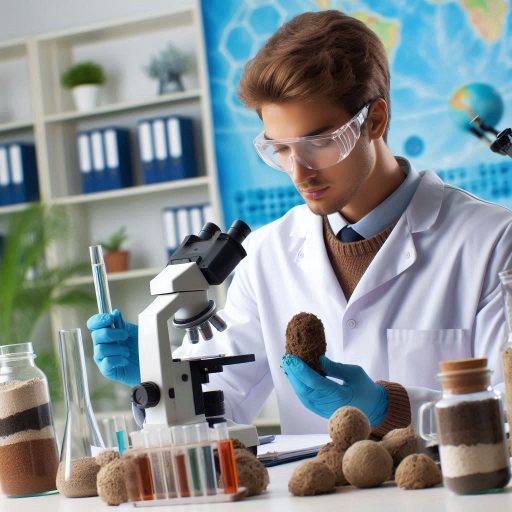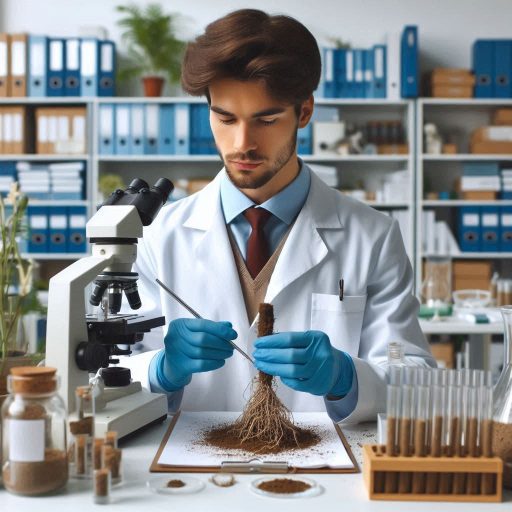Introduction
Soil scientists study soil properties, composition, and behavior to understand ecosystems and agricultural systems as soil scientist Toolbox.
They assess soil health and its impact on plant growth.
Soil scientists also investigate soil interactions with water, air, and living organisms.
Having the right equipment is crucial in soil science research.
Accurate measurements and analyses depend on quality tools.
Proper equipment ensures that scientists can gather reliable data to support their findings.
Each tool plays a specific role in the research process.
Soil sampling tools help collect representative soil samples, which are essential for accurate assessments.
pH meters measure soil acidity, influencing plant growth and nutrient availability.
Moisture meters gauge soil water content, informing irrigation practices.
Texture analysis tools determine soil composition, impacting its ability to retain water and nutrients.
Furthermore, technology such as GPS and GIS enhances data collection and mapping capabilities.
Soil scientists rely on various tools to conduct effective research.
The right equipment empowers them to analyze soil accurately and contribute to sustainable land management practices.
With quality instruments, soil scientists can make informed decisions that benefit agriculture and the environment.
Soil Sampling Tools
Description of Core Sampling Tools
Soil sampling tools are essential for collecting accurate soil samples.
Core sampling tools allow scientists to extract undisturbed soil samples from the ground.
These tools usually feature a cylindrical design, enabling scientists to obtain a representative soil profile.
They come in various sizes, depending on the type of analysis required.
Common core samplers include the hand auger, slide hammer, and the hydraulic corer.
The hand auger is a simple, manual tool ideal for shallow sampling.
It consists of a long handle with a metal auger attached.
The slide hammer is used for deeper sampling, employing a weight that drives the sampler into the soil.
Hydraulic corers are powerful machines that extract larger soil cores, perfect for extensive investigations.
Importance of Proper Soil Sampling Techniques
Proper soil sampling techniques are crucial for obtaining reliable data.
Inaccurate sampling can lead to misleading results, impacting research and recommendations.
Therefore, it is essential to follow standardized methods for sample collection.
Soil scientists should choose representative locations and depths when sampling.
Additionally, they should ensure that samples are collected during dry conditions.
This minimizes the risk of contamination and improves the accuracy of results.
Once samples are collected, proper handling and storage are vital to maintain soil integrity.
Types of Soil Probes Used in Soil Sampling
Several types of soil probes assist scientists in collecting samples.
One common type is the auger probe, which is ideal for loose soils.
Auger probes can be manual or motorized, making them versatile for various conditions.
Another type is the trowel probe, which is effective for shallow sampling.
Trowel probes allow for quick access to the upper soil layers, facilitating rapid analysis.
Additionally, soil moisture probes measure moisture content during sampling.
These probes provide valuable data on soil water availability.
Pneumatic and electric soil probes are also available for larger projects.
They reduce labor and increase efficiency, allowing for extensive sampling in shorter timeframes.
Soil sampling tools play a vital role in soil science.
Core sampling tools enable scientists to collect accurate and representative soil samples.
Proper sampling techniques ensure reliable results, guiding essential agricultural and environmental decisions.
Different types of soil probes cater to various needs, enhancing sampling efficiency.
By equipping themselves with the right tools, soil scientists can effectively contribute to our understanding of soil health and sustainability.
Read: Profiles in Success: Leading Chemists of the 21st Century in the US
pH Meters and Testing Kits
Importance of Measuring Soil pH
Measuring soil pH is essential for assessing soil health.
Soil pH influences nutrient availability and microbial activity.
Most plants thrive in a pH range of 6.0 to 7.5.
When soil pH falls outside this range, it can hinder plant growth.
Acidic soils may limit the availability of essential nutrients like phosphorus and nitrogen.
Conversely, alkaline soils can lead to nutrient deficiencies as well.
Therefore, maintaining optimal soil pH is crucial for successful agriculture and gardening.
Soil pH testing helps farmers and gardeners make informed decisions about soil amendments and fertilizer applications.
Different Types of pH Meters Available
Several types of pH meters are available for measuring soil acidity.
Digital pH meters provide accurate and quick readings, making them popular among professionals.
They usually feature a probe that inserts directly into the soil.
Some digital meters offer advanced features, such as automatic temperature compensation and data logging.
Soil pH test strips are another option, offering a simple and cost-effective method.
These strips change color based on the soil pH level.
While they may lack precision, they are easy to use and interpret.
Analog pH meters are also available, though they are less common today.
These meters typically require manual calibration and may be more challenging to read.
Selecting the right type of pH meter depends on the user’s needs and budget.
How to Use Testing Kits Effectively
Using soil testing kits effectively involves following specific steps for accurate results.
First, collect soil samples from various locations in the area.
This practice ensures that the sample represents the entire field or garden.
Next, follow the instructions included with the testing kit.
Most kits require mixing soil with distilled water to create a slurry.
After preparing the sample, add the provided pH indicator solution.
Stir the mixture thoroughly to ensure proper mixing.
Allow the mixture to settle for the time specified in the instructions.
Then, compare the resulting color to the provided pH chart.
This step helps determine the soil’s pH level accurately.
For more precise results, calibrate pH meters according to the manufacturer‘s guidelines.
Regular calibration ensures accuracy and reliability in readings.
Additionally, clean the electrode probe after each use to maintain its lifespan and performance.
Measuring soil pH is vital for effective soil management.
Various pH meters and testing kits cater to different needs and budgets.
By understanding how to use these tools effectively, soil scientists and gardeners can ensure optimal soil conditions for healthy plant growth.
Accurate pH measurements ultimately lead to improved agricultural practices and sustainable land use.
Read: The Life and Times of a U.S. Physicist: A Day in Detail
Moisture Meters
Why Measuring Soil Moisture is Crucial
Measuring soil moisture is essential for plant health and crop productivity.
Plants depend on water for photosynthesis and nutrient transport.
Insufficient moisture can lead to plant stress, reduced growth, and lower yields.
Conversely, excessive moisture can cause root rot and other diseases.
Therefore, understanding soil moisture levels helps manage irrigation effectively.
It also prevents overwatering and conserves water resources.
In agriculture, accurate moisture measurements enhance decision-making regarding irrigation scheduling.
This practice helps optimize water use, improves crop quality, and increases profitability.
Additionally, monitoring soil moisture aids in assessing soil health and overall ecosystem function.
Types of Moisture Meters Used by Soil Scientists
Soil scientists use several types of moisture meters to measure soil water content.
One common type is the capacitive moisture meter.
This device measures changes in capacitance caused by water presence in the soil.
Capacitive meters are often favored for their accuracy and ease of use.
Another type is the resistive moisture meter, which operates by measuring the electrical resistance of the soil.
As moisture content increases, resistance decreases, allowing for water content determination.
While resistive meters are generally less expensive, they may require more calibration.
Tensiometers are also popular among soil scientists.
These devices measure soil water tension, indicating how tightly soil holds water.
Tensiometers provide valuable information about irrigation needs and soil moisture availability.
Some advanced moisture meters feature data logging capabilities and connectivity options.
These devices allow users to monitor soil moisture over time and analyze trends.
How to Interpret Moisture Readings Accurately
Interpreting moisture readings accurately involves understanding the meter‘s scale and context.
Begin by taking multiple measurements across the area of interest.
This practice ensures that the readings represent the entire field or garden.
When using capacitive or resistive meters, refer to the manufacturer‘s guidelines for interpreting readings.
Most meters display moisture levels as a percentage or relative scale.
Higher percentages indicate wetter soil, while lower percentages suggest drier conditions.
For tensiometers, check the water tension gauge.
A lower reading indicates that the soil has adequate moisture, while higher readings suggest that the soil is dry and requires watering.
Consider the specific moisture requirements of the plants being cultivated.
Different plants have varying water needs, so compare the readings against these requirements.
Additionally, use moisture readings in conjunction with weather data and soil type.
Factors such as rainfall, temperature, and soil composition can influence moisture levels.
Regularly calibrate your moisture meters according to the manufacturer’s recommendations.
Calibration ensures consistent accuracy and reliability in readings over time.
Measuring soil moisture is crucial for effective soil management and plant health.
Various moisture meters help scientists assess soil water content accurately.
By interpreting moisture readings correctly, users can make informed decisions about irrigation and soil management practices.
Read: Salary Ranges: What to Expect as a Physicist in the USA

Soil Texture Analysis Tools
Importance of Understanding Soil Texture
Understanding soil texture is crucial for effective land management.
Soil texture refers to the proportion of different particle sizes, including sand, silt, and clay.
Each texture influences water retention, drainage, and nutrient availability.
For example, sandy soils drain quickly but retain less water.
Conversely, clay soils hold water well but may drain poorly.
Soil texture also affects root penetration and plant growth.
Different crops thrive in specific soil textures, impacting agricultural productivity.
For example, root vegetables prefer loose, sandy soils, while grains may favor loam.
Additionally, understanding soil texture helps in designing effective erosion control and conservation strategies.
Soil texture can also influence soil temperature and biological activity, further impacting plant growth.
Tools Used for Soil Texture Analysis
Several tools assist soil scientists in analyzing soil texture.
The soil texture triangle is a common tool used to classify soil textures based on particle size distribution.
This triangle visually represents the relationship between sand, silt, and clay percentages.
Sieve sets are also essential for texture analysis.
These sets allow scientists to separate soil particles by size.
The sieve method involves passing soil through various mesh screens, capturing different particle sizes.
Another useful tool is the hydrometer, which measures the density of soil particles suspended in water.
This tool helps determine the proportion of silt and clay in the soil.
Hydrometer analysis provides detailed information about soil texture, aiding in classification.
Textural kits are available for field analysis.
These kits often include tools for conducting both the ribbon test and the jar test.
How to Conduct Soil Texture Tests in the Field
Conducting soil texture tests in the field requires specific steps to ensure accuracy.
Start by collecting a representative soil sample.
Dig a hole about six inches deep and gather soil from the middle layer.
For the ribbon test, take a small amount of moistened soil and squeeze it between your fingers.
If the soil forms a long ribbon, it indicates high clay content.
If the ribbon crumbles easily, the soil may contain more sand.
For the jar test, fill a clear jar with a soil sample and water.
Shake the jar vigorously for a few minutes, then let it sit undisturbed.
Over time, soil particles will settle into distinct layers.
The sand will settle at the bottom, followed by silt, and clay will remain suspended longer.
Measure the height of each layer to determine the percentage of each soil particle size.
After conducting these tests, compare your results to the soil texture triangle.
Use the proportions of sand, silt, and clay to classify the soil texture.
Understanding soil texture is vital for successful land management.
Various tools and techniques assist in analyzing soil texture effectively.
By conducting field tests, soil scientists can gain valuable insights into soil properties, improving agricultural practices and conservation efforts.
Read: Physics Specializations: Choosing Your Path in the U.S.
Organic Matter Content Assessment Equipment
Significance of Measuring Organic Matter in Soil
Measuring organic matter content is essential for understanding soil health.
Organic matter enhances soil fertility by providing essential nutrients for plant growth.
It improves soil structure, promotes water retention, and supports microbial activity.
High organic matter levels increase soil resilience against erosion and compaction.
Furthermore, organic matter plays a crucial role in carbon sequestration.
By storing carbon, healthy soils can mitigate climate change.
Understanding organic matter content helps farmers optimize their practices for better crop yields.
It also assists environmental scientists in assessing ecosystem health.
Tools for Organic Matter Analysis
Several tools are available for assessing organic matter content in soil.
Flame photometers are commonly used for measuring nutrient levels.
These instruments measure the intensity of light emitted by elements in the soil.
While not specifically designed for organic matter, flame photometers can provide related data, aiding in overall soil analysis.
Spectrophotometers are more directly related to organic matter assessment.
These devices analyze the absorbance of light by soil samples.
Different wavelengths correspond to various soil components, allowing scientists to estimate organic matter content.
By measuring how much light is absorbed, researchers can infer the concentration of organic matter.
Loss-on-ignition (LOI) is another popular method for assessing organic matter.
This technique involves heating a soil sample to burn off organic matter.
The weight loss indicates the amount of organic matter present.
LOI is straightforward and widely used in laboratories for organic matter assessments.
Techniques for Determining Organic Matter Content
Determining organic matter content involves several techniques.
First, collect a representative soil sample.
This sample should reflect the typical conditions of the area being studied.
Next, dry the soil sample in an oven at a specified temperature.
This drying process helps eliminate moisture, ensuring accurate measurements.
After drying, weigh the sample to establish its initial weight.
If using the LOI method, heat the dried soil sample in a furnace.
A common temperature is around 360‘C (680‘F) for several hours.
After heating, allow the sample to cool and weigh it again.
The weight loss during heating indicates the organic matter content.
If using spectrophotometry, dissolve the soil sample in a suitable solvent.
This solution allows for the analysis of organic compounds.
Use the spectrophotometer to measure the absorbance at specific wavelengths.
Compare the results with a standard curve to determine organic matter concentration.
Flame photometry can also provide additional insights into the nutrient status related to organic matter.
This data can be useful for interpreting soil health and fertility.
Assessing organic matter content is vital for evaluating soil health.
Tools like flame photometers and spectrophotometers aid in this analysis.
By employing effective techniques, soil scientists can better understand organic matter dynamics, supporting sustainable agricultural practices and environmental conservation.
Transform Your Career Today
Unlock a personalized career strategy that drives real results. Get tailored advice and a roadmap designed just for you.
Start NowUncover the Details: Hydrologist Work-Life Balance: Tips and Strategies
Discover More: How Hydrologists Contribute to Sustainable Development
GPS and GIS Technology
Role of GPS in Soil Science Research
Global Positioning System (GPS) technology plays a vital role in soil science research.
GPS helps scientists accurately locate sampling sites in the field.
It provides precise coordinates, ensuring repeatability and consistency in soil sampling.
This precision enhances data quality and reduces errors during analysis.
Researchers use GPS to track changes in soil properties over time.
By comparing historical data with current measurements, scientists can assess trends in soil health.
GPS also aids in field navigation, making it easier to reach remote sampling locations.
Efficient navigation allows researchers to focus more on data collection than logistics.
Moreover, GPS technology facilitates large-scale agricultural studies.
Researchers can analyze soil properties across extensive areas, helping them understand regional variations.
This information is crucial for developing site-specific management practices.
How GIS Technology Helps in Mapping Soil Properties
Geographic Information System (GIS) technology complements GPS by providing advanced mapping capabilities.
GIS allows scientists to visualize and analyze spatial data related to soil properties.
Researchers can overlay various datasets, such as soil type, land use, and topography, for comprehensive analysis.
Using GIS, scientists can create detailed soil maps that depict different soil characteristics.
These maps help identify patterns and relationships between soil properties and environmental factors.
For example, researchers can analyze how soil types affect water drainage or nutrient availability.
GIS also assists in modeling soil erosion and predicting its impact on agricultural productivity.
By understanding these dynamics, scientists can recommend effective soil conservation strategies.
Benefits of Using GPS and GIS Tools in Soil Research
The integration of GPS and GIS technology in soil research offers numerous benefits.
First, it enhances data accuracy and consistency, leading to more reliable results.
Accurate data improves decision-making for land management and agricultural practices.
Second, GPS and GIS streamline fieldwork.
Researchers can efficiently plan sampling routes, minimizing time spent in the field.
This efficiency allows scientists to collect more data in less time, increasing research productivity.
Third, these technologies promote collaboration among researchers.
By sharing GPS and GIS data, scientists can work together on joint projects.
Collaborative efforts lead to richer datasets and more comprehensive analyses.
Furthermore, GIS technology enables long-term monitoring of soil health.
Researchers can track changes in soil properties over time, identifying trends and potential issues.
This monitoring is crucial for sustainable land management practices.
GPS and GIS technology significantly enhance soil science research.
GPS provides precise location data, while GIS enables comprehensive mapping and analysis of soil properties.
Together, these tools improve data accuracy, streamline fieldwork, and support sustainable practices in agriculture and environmental conservation.
Adopting GPS and GIS technologies will be essential for advancing soil science and addressing global challenges related to soil health and sustainability.
Soil Compaction Testing Equipment
Impact of Soil Compaction on Crop Growth
Soil compaction significantly affects crop growth and overall soil health.
Compacted soil reduces pore space, restricting air and water movement.
This reduction hampers root development, limiting the plant’s ability to absorb nutrients.
As a result, crops may exhibit stunted growth and decreased yields.
Compaction also negatively impacts soil organisms, which are essential for maintaining soil health.
Earthworms and beneficial microbes struggle to thrive in compacted conditions.
These organisms improve soil structure and nutrient cycling.
Thus, soil compaction can create a detrimental cycle that affects agricultural productivity.
Effective soil management practices are essential to prevent compaction.
Farmers should monitor soil compaction levels regularly to ensure optimal crop growth.
Understanding soil compaction’s impact helps farmers make informed decisions about land management.
Tools for Soil Compaction Testing
Several tools are available for testing soil compaction.
Penetrometers are one of the most commonly used instruments.
They measure the resistance of soil to penetration, providing valuable data on compaction levels.
Cone penetrometers offer a more advanced option for assessing soil compaction.
These devices feature a cone-shaped tip that penetrates the soil, measuring resistance at various depths.
Cone penetrometers provide detailed profiles of soil compaction, aiding in effective soil management.
Additionally, portable soil compaction testers allow for easy field measurements.
These tools can quickly determine soil compaction levels across different locations.
Accurate measurements enable farmers to identify areas that require attention.
Methods for Assessing Soil Compaction Levels
There are several methods for assessing soil compaction levels.
The most common method involves measuring soil penetration resistance using a penetrometer.
This method provides immediate feedback on compaction levels in the field.
Another effective technique is the bulk density method.
This method involves extracting a soil sample, weighing it, and calculating its volume.
Higher bulk density readings indicate more compacted soil.
Farmers can also use visual assessments to identify compacted areas.
Signs of compaction include poor drainage, surface cracking, and limited root growth.
By recognizing these indicators, farmers can address compaction issues early.
Regular monitoring of soil compaction levels is crucial for sustainable agriculture.
Using these tools and methods, farmers can maintain optimal soil health.
Healthy soil supports robust crop growth and enhances agricultural productivity.
Soil compaction testing equipment plays a vital role in sustainable agriculture.
By measuring compaction levels, farmers can understand their soil’s health.
Tools like penetrometers and cone penetrometers provide essential data for effective soil management.
Implementing regular soil compaction assessments will improve crop growth and support long-term agricultural sustainability.
Delve into the Subject: Innovative Research Projects in Modern Paleontology
Conclusion
A well-equipped soil scientist’s toolbox is essential for effective research and analysis.
Quality tools enable accurate assessments of soil properties and conditions.
Each tool plays a unique role in understanding soil behavior and composition.
From sampling tools to advanced technology, every piece of equipment matters.
Investing in reliable instruments ensures accurate and consistent results in soil research.
Proper soil sampling techniques yield more representative data, enhancing study validity.
pH meters, moisture meters, and texture analysis tools provide critical insights into soil health.
Furthermore, GPS and GIS technology aid in mapping and analyzing soil properties effectively.
Aspiring soil scientists should prioritize quality equipment in their research endeavors.
Investing in the right tools enhances data accuracy and supports better decision-making.
This investment fosters a deeper understanding of soil and its role in ecosystems.
As future professionals in soil science, embrace the importance of a well-equipped toolbox.
Quality equipment leads to improved research outcomes and promotes sustainable land management practices.
Equip yourself with the best tools available to contribute effectively to the field.
With the right tools, you can advance soil science and promote environmental sustainability.
[E-Books for Sale]
The Big Book of 500 High-Paying Jobs in America: Unlock Your Earning Potential
$19.99 • 500 High-Paying Jobs • 330 pages
Explore 500 high-paying jobs in America and learn how to boost your career, earn more, and achieve success!
See All 500 High-Paying Jobs of this E-Book
1001 Professions Without a Degree: High-Paying American Jobs You Can Start Now
$19.99 • 1001 Professions Without a Degree • 174 pages
Discover 1001 high-paying jobs without a degree! Unlock career tips, skills, and success strategies for just $19.99!




